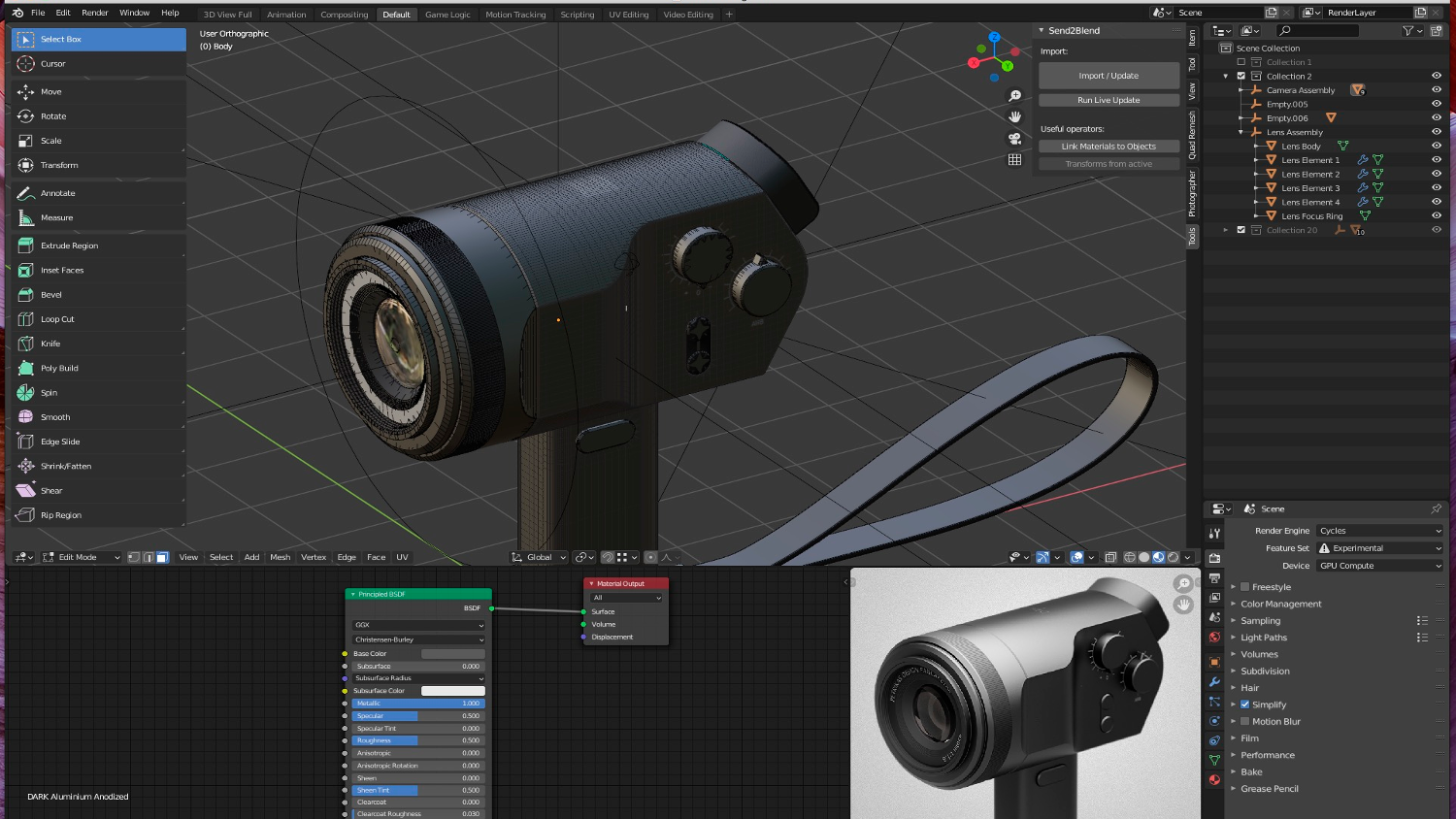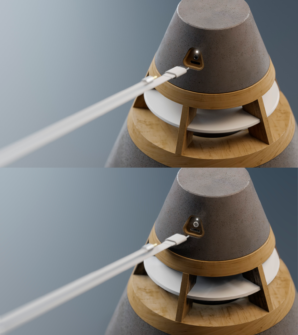Blender 2.9 – It’s time professionals took Blender seriously. With Version 2.9, this open source product, which supports a huge range of 3D creation needs, is truly ready for business, writes Mindaugas Petrikas
To some people, Blender is just ‘that nerdy little open source application for kids who use Linux’. They should look a little harder, because this mesh modelling software actually represents a one-stop-shop for a huge range of 3D creation needs: modelling, rigging, animation, simulation, rendering, compositing and motion tracking, video editing and 2D animation.
In short, it’s a product that professionals across many different industry sectors can’t afford to ignore.
That’s down, in part, to Blender’s fast-paced development cycle. With the mid-2019 release of version 2.8, the Blender Foundation, home of the Blender project, made it clear that Blender means business. And that message has been heard, loud and clear, by recent corporate recruits to the Blender Development Fund, including Microsoft, Intel, Unity, Nvidia, AMD and EPIC.
Big-name supporters aside, the new version 2.9 takes serious steps to make sure Blender is no longer a crazy maze of User Interface (UI) elements, riddled with bugs and cryptic functions. Its brand-new UI is simpler to understand. Most bugs get swatted in pre-release versions. Overall stellar stability is now one of the software’s main selling points – or would be, if the product was for sale.
As with other open source products, it’s free for anyone to download and use. (That said, donations and support are highly encouraged, not least to pay the team of 24 full-time professionals working at the Blender Institute to further improve the product).

A free tool that provides a complete 3D pipeline inevitably attracts comparisons to very expensive, proprietary software products that do the same job. But once you look beyond cost (or lack of cost), what really defines Blender is its modularity, flexibility, fluidity and adaptivity.
It has already adopted cutting-edge tools that look set to become industry-standard: OpenColorIO for colour management; OpenEXR for image storing; and the Open Shading Language, OSL.
The list expands constantly, as people from the Blender user community around the world share their knowledge and their workflows.
These people are frequently experts in sometimes quite niche fields. They have the ability to look at Blender’s code, with specific jobs in mind, and say, ‘Hey, this can be improved’. Thanks to their efforts, Blender has moved beyond a ‘does the job’ mentality often seen in software, in a quest to become ‘the only tool that does the job right.’
On a personal level, I’ve been a big supporter of Blender Cycles, its RGB ray tracing rendering engine.
Those involved with developing Cycles have always been strong proponents for GPU rendering – and, as it turns out, they were right. GPU rendering is faster, easier to scale and more mobile than CPU rendering, especially on a budget.
Purchasing a couple of graphics cards and just plugging them in can yield results at speeds that were previously only possible in render farms. It’s also worth noting that even current gaming laptops come with desktop-grade graphics cards that can render up to four times faster than their built-in CPUs.

That’s why I would never stray away from Cycles. I have tried many, many rendering solutions, but none of them have matched my particular needs.
It’s especially difficult to turn away from Cycles when new features surface on an almost weekly basis, thanks to a developer community made up of professionals from many different industries, all committed to chipping in and pushing it even further.
One gigantic step towards photorealism is Troy Sobotka’s Filmic Blender, a high dynamic range transform function with intensity gamut mapping. This makes scene-referred workflow a breeze, supports great, intuitive post-processing flexibility and, above all, delivers stunningly photorealistic results.
A group of stubborn developers and colourists are now determined to turn Cycles into a spectral renderer – a project that’s already reaping promising results.
The feature list goes on and on, literally, as new plug-ins and tools are introduced daily. It would take a weekly article to cover them all and stay up to date.
New renderer: Eevee
Another exciting Blender tool in development is the real-time render engine Eevee. This has already drawn a huge following from the CGI community, where members are already using it to produce jaw-dropping short films. But it’s also great news for the humble product designer.
Being able to create product animation renders in 10 seconds rather than 10 hours is nothing short of amazing.
Working with Eevee, however, may be somewhat different to what they’re accustomed to. As it’s not a ray tracing engine, you can’t fully trust it to do its own thing. In other words, the results you’ll get will be closely related to the settings you input.

The grass on the other side is definitely green, but crossing the fence is not as easy as it might look. First of all, Blender provides no assisted support. So if you get an error, if things just do not add up, if you lose your work or your machine catches on fire, you should be prepared to do some Googling, in order to get answers.
There is no number to phone, no email address to contact.
You can shake your fist at the sky or send out an angry tweet – but all problems and issues will either need to be fixed by yourself, or by kind-hearted developers in the Blender community.
That said, Blender is incredibly stable, not to mention widely discussed.
Most user-error problems are covered in detail on forums, on Youtube, and on many other platforms.
There is also a bright side to this. If you find a bug and file a bug report, depending on the severity of the problem, it could well have been fixed by the time you next turn on your computer.
I’ve been using Blender since 2010, a few years before my interest in product design peaked. I initially started with poly modelling, but as I began to explore the world of product design, I quickly came to realise that it was far from the ideal workflow.
Enter solid modelling, the worst enemy of any poly-based software. Any solid object imported into a poly modeller needs to be tessellated. That happens either on export (for example, exporting STL from Autodesk Fusion 360) or on import (importing STEP into Keyshot).
Neither is ideal, since deliberately hand-sculpted geometry gets remeshed, according to what the software believes to be right. And while many software packages provide easy-to-use tools for fixing minor issues, it’s always a bit of a lottery. Does your object show up correctly in the renderer – or are you looking at another evening spent painstakingly selecting edges and vertices and specifying their purpose?
This can be especially painful for a concept designer, who needs to view their designs quickly and often.
This is a battle I have been fighting for some time now. Companies keen to keep their customers tied to their ecosystems are pretty reluctant to develop good export tools, for obvious reasons.
But it means that designers and other creatives are left to develop tools and workflows themselves.
I have also been introduced to another hidden gem of an application called Moment of Inspiration, or MoI. This can read solid modelling objects (STEP, IGES, and so on) and export them as meshes (OBJ, FBX, etc). These file formats are superior to STL, in the sense that they can carry over more information, such as UV maps, sharp edges, even basic materials.
But wait, it gets better! MoI has a unique (to my knowledge) tessellation feature able to export N-gons. The resulting mesh is much cleaner, has all sharp edges marked and can be UV-unwrapped with ease. The Export-Import-Export-Import workflow is tedious, but from my personal experience, is well worth the effort involved.
In conclusion
Now that we know how to push a square peg through a triangular hole, we can enjoy a full spectrum of features that would enable any creative to express themselves fully.
For product design, I am a big fan of automation. Need five different camera angles, each with five different colour schemes? Set a few animation keys for camera switching and a few keys for material colour. Click render and enjoy a nice cup of tea while the export folder is populated with 25 different renders.
Got an old scene that you were really happy with and want to use again on a current project? Open two Blender windows and simply copy-paste the objects, complete with all information such as material nodes, animations and so on.
Pushing rendering for product design further, video editing and compositing tools in Blender are very handy as well.
Capturing a real-life scene with a camera and using that video footage as an environment in which to place your object is no longer a team effort. Environment preparation and lighting set-up, footage stabilisation, motion tracking, shadow-capturing, matching and post-processing are all done in Blender, too.
And it can all be learnt from a 20-minute Youtube tutorial, if you already know your way around Blender’s user interface (UI). Ah yes, the infamous Blender UI: buttons without icons; scrolling windows within scrolling windows; tabs within tabs within tabs. Opening a file saved by your colleague and getting a completely different UI.
While some of these criticisms still hold up, the situation is improving. Version 2.80 has seen a lot of focus on helping very new users feel a little less daunted and, in turn, the whole UI got a revamp. It is now a lot more intuitive and user-friendly. Once the UI ‘clicks’, it is difficult to look back.
But in the end, it’s modularity that makes Blender so good. Its flexibility and the fact that it is open source makes it easy for software developers to write plug-ins.
This, in turn, means that many thirdparty applications play nicely with Blender. They include Adobe Substance Painter and Substance Designer, Unity, Unreal Engine, fSpy, and more recently, HDR Light Studio, to name just a few.
If endless github pages of plug-ins, extra tools and unlimited potential to push your renders further is not what you are after, then Blender might not be the right tool for your toolbox.
Many product designers I know, for example, are very happy with Keyshot, and I completely understand why. It is as close to a ‘one-click’ solution as it currently gets and delivers rather impressive results.
However, if you’re someone whose computer is their virtual shed, if you enjoy tinkering and honing your skills in your time off, then there’s a whole world of possibilities waiting, packaged in a swirly orange icon.






